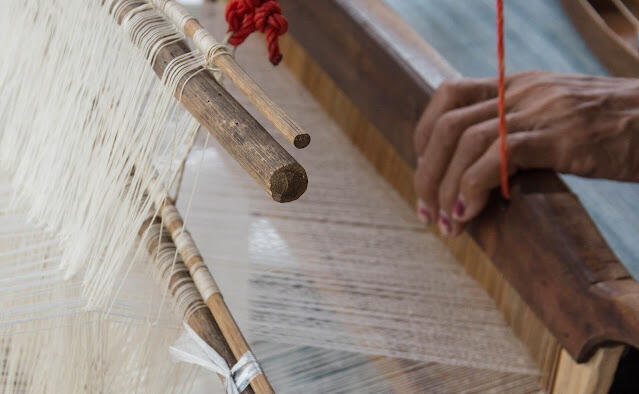The Fabric of India’s Freedom and Self-Reliance
In the grand tapestry of India’s history, one fabric stands out as a symbol of resilience, self-sufficiency, and independence. Khadi, often referred to as “the fabric of freedom,” is more than just a textile; it’s a testament to a nation’s spirit and its journey towards self-reliance. Let’s delve into the captivating narrative of Khadi, from its humble origins to its enduring legacy.



A Humble Beginning: The Birth of Khadi
Khadi’s story begins in the early 20th century when India was under British colonial rule. As the Indian freedom struggle gained momentum, the need for self-reliance became apparent. Mahatma Gandhi, the iconic leader of India’s independence movement, saw the potential of Khadi as a means of economic empowerment for millions of Indians and as a tool of resistance against British oppression.
1. Gandhi’s Vision: At the forefront of Khadi’s resurgence was Mahatma Gandhi’s unwavering vision. He believed that spinning and weaving one’s cloth would not only provide economic independence to the masses but also challenge the British monopoly on textiles.
2. Swadeshi Movement: The Swadeshi Movement, which encouraged Indians to use locally made products, was closely associated with Khadi. It aimed to reduce dependence on British goods and promote indigenous industries.
The Craftsmanship of Khadi
Khadi is not just a fabric; it’s a manifestation of human skill, patience, and dedication. The process of making Khadi is as intricate as the fabric itself.
1. Hand Spinning: At the heart of Khadi production is the charkha, a small, hand-cranked spinning wheel. Skilled artisans use the charkha to spin cotton or silk fibers into yarn. This process is not just about making thread; it’s about connecting to one’s heritage and history.
2. Weaving: After the yarn is spun, it’s woven into fabric using traditional handloom techniques. Khadi’s unique texture and appearance come from the traditional wooden looms employed by artisans.
3. Natural Dyes: Khadi is often dyed using natural and eco-friendly dyes, reflecting its commitment to sustainability. These dyes not only produce vibrant colors but also align with the philosophy of simplicity and harmony.
The Symbolism of Khadi
Khadi carries profound symbolism that goes beyond its role as clothing material.
1. Self-Reliance: Khadi represents economic self-reliance. By wearing and promoting Khadi, Indians were taking a step towards financial independence and reducing their reliance on British-manufactured textiles.
2. Resistance: During India’s struggle for independence, Khadi became a symbol of resistance. It was worn as a political statement against British rule and their exploitative policies.
3. Simplicity: Khadi aligns with the principle of simplicity, which was dear to Gandhi’s heart. It represents a return to traditional values and a rejection of excessive consumerism.
A Symbiotic Relationship
Khadi and the Indian freedom movement were deeply intertwined. The fabric played a pivotal role in shaping the course of history.
1. The Salt March: Perhaps one of the most iconic moments in India’s struggle for independence was Gandhi’s Salt March. He walked over 240 miles to the Arabian Sea to protest the British monopoly on salt production, wearing nothing but a simple Khadi dhoti.
2. Boycott of British Goods: As part of the Swadeshi Movement, Indians boycotted British-made textiles and embraced Khadi. This boycott had a significant economic impact on the British Empire.
3. Empowering the Masses: Gandhi saw Khadi as a means to empower the masses, particularly the rural poor. He believed that spinning Khadi could provide livelihoods to millions of Indians.
The Legacy of Khadi: Beyond Independence
Khadi’s impact extended far beyond India’s independence. It left an indelible mark on the nation’s culture, politics, and identity.
1. Political Influence: The use of Khadi in India’s political landscape continues to this day. It’s often worn by political leaders as a symbol of simplicity, humility, and connection to the masses.
2. Cultural Significance: Khadi is deeply ingrained in India’s cultural identity. It’s worn during festivals, weddings, and other celebrations, signifying tradition and heritage.
3. Global Recognition: Khadi has gained recognition on the global stage. It’s celebrated for its eco-friendliness, sustainability, and timeless appeal. Designers worldwide have embraced Khadi in their collections.
Revival of Khadi: A Modern Resurgence
In recent years, Khadi has experienced a renaissance, blending tradition with contemporary fashion and global appeal.
1. Fashion Industry: Khadi has found a prominent place in the fashion industry. Renowned designers have incorporated Khadi into their collections, making it fashionable and relevant in today’s world.
2. Sustainable Choice: As sustainability gains prominence, Khadi’s eco-friendly and biodegradable nature aligns perfectly with the values of conscientious consumers.
3. Rural Empowerment: The revival of Khadi has led to increased employment opportunities in rural India. It’s not just a fabric; it’s a lifeline for many communities.
Conclusion: Khadi’s Timeless Tale
Khadi’s story is one of resilience, resistance, and resurgence. It’s a fabric that embodies the spirit of a nation and the ideals of self-reliance and simplicity. From its role in India’s fight for freedom to its contemporary relevance in the fashion industry, Khadi continues to inspire and connect people worldwide. As we celebrate this remarkable fabric, we honor the legacy of Mahatma Gandhi and the countless artisans who have spun the threads of India’s history with their skilled hands. Khadi isn’t just a fabric; it’s a living testament to the enduring spirit of a nation.


